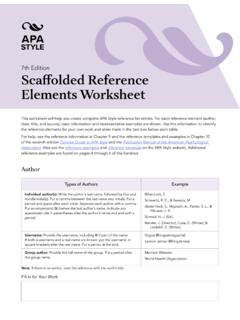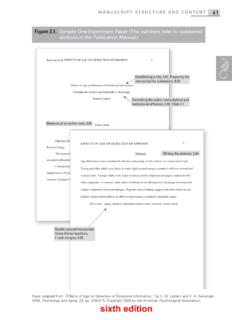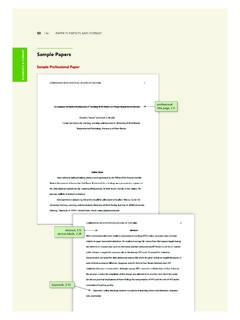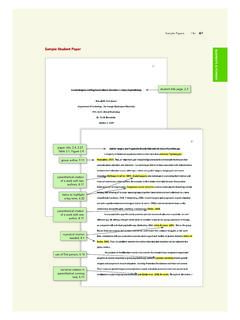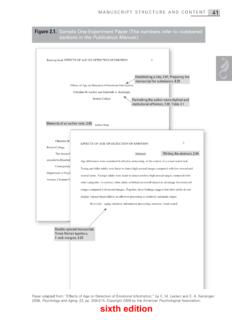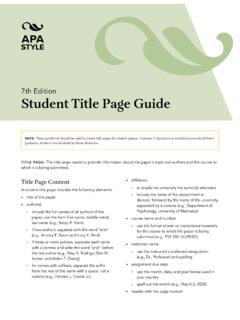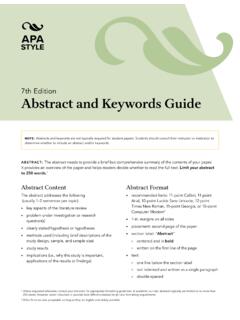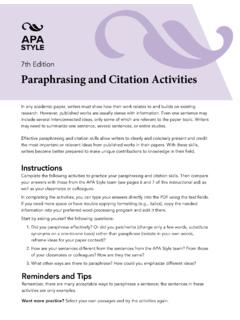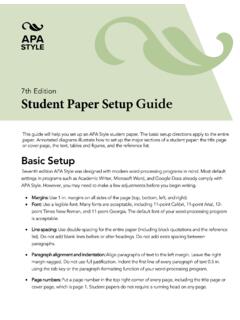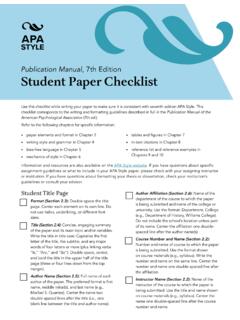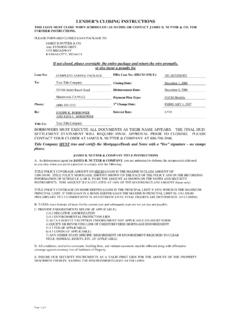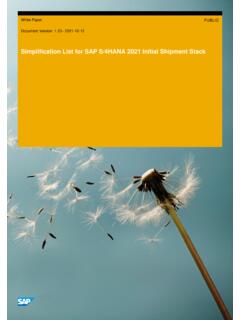Transcription of Concise Guide, 7th Edition Student Paper Checklist
1 Concise guide , 7th EditionStudent Paper ChecklistUse this Checklist while writing your Paper to make sure it is consistent with seventh Edition APA Style. This Checklist corresponds to the writing and formatting guidelines described in full in the Concise guide to APA Style (7th ed.).Refer to the following chapters for specific information: Paper elements and format in Chapter 1 writing style and grammar in Chapter 2 bias-free language in Chapter 3 punctuation, lists, and italics in Chapter 4 spelling, capitalization, and abbreviations in Chapter 5 numbers and statistics in Chapter 6 tables and figures in Chapter 7 in-text citations in Chapter 8 reference list and reference examples inChapters 9 and 10 Information and resources are also available on the APA Style website.
2 If you have questions about specific assignment guidelines or what to include in your APA Style Paper , please check with your assigning instructor or institution. If you have questions about formatting your thesis or dissertation, check your institution s guidelines or consult your Title PageFormat (Section ): Double-space the title page. Center each element on its own line. Do not use italics, underlining, or different font (Section ): Concise , engaging summaryof the Paper and its main topic and/or the title in title case: Capitalize the first letter of the title, the subtitle, and any major words of four letters or more (plus linking verbs Is, Are, and Be ). Double-space, center, and bold the title in the upper half of the title page (three or four lines down from the top margin).
3 Author Name (Section ): Full name of each author of the Paper . The preferred format is first name, middle initial(s), and last name ( , Maribel S. Quantez). Center the name two double-spaced lines after the title ( , one blank line between the title and author name).Author Affiliation (Section ): Name of the department of the course to which the Paper is being submitted and name of the college or university. Use the format: Department, College ( , Department of History, Williams College). Do not include the school s location unless part of its name. Center the affiliation one double-spaced line after the author name(s).Course Number and Name (Section ): Number and name of course to which the Paper is being submitted. Use the format shown on course materials ( , syllabus).
4 Write the number and name on the same line. Center the number and name one double-spaced line after the Name (Section ): Name of the instructor of the course to which the Paper is being submitted. Use the title and name shown on course materials ( , syllabus). Center the name one double-spaced line after the course number and Date (Section ): Due date of the assignment. Include the month, day, and year in the format used in your country ( , May 4, 2020, or 4 May 2020). Spell out the month and write the full year. Center the date one double-spaced line after the instructor Header (Section ): Page number 1. Flush right in the header (upper right corner). Paper FormatPage Header (Section ): Page number. Appears flush right in the header (upper right corner) of all pages.
5 Insert page numbers using the automatic page-numbering function of your word-processing and Font Size (Section ): Use the same font and font size throughout your Paper (exception: figure images require a sans serif font and can use various font sizes). Recommended serif and sans serif fonts: 11- p o i n t C a l i b r i 11-point Arial 10-point Lucida Sans Unicode 12-point Times New Roman 11-point Georgia 10-point Computer ModernLine Spacing (Section ): Double-space the entire Paper . Do not add extra lines before or after headings or between (Section ): Margins are 1 in. on all sides (top, bottom, left, and right).Paragraph Alignment and Indentation (Sec tions ): Left-align the text (do not use full justification).
6 Indent the first line of each paragraph in. (one tab key). Paper Length (Section ): Follow the assignment guidelines. If not instructed otherwise, use the word-count function of your word-processing program to determine Paper length, counting every word in the Paper but do not count words in figure OrganizationIntroduction (Section ): Repeat the Paper title on the first line of the first page of text, before the opening paragraph. Center and bold the title. Do not include an Introduction heading. Start the first line of the text one double-spaced line after the title. Use Level 2 headings for subsections in the (Section ): Use headings as needed to organize the text. Use Level 1 headings for main sections after the introduction ( , Method, Results, Findings, Discussion).
7 Page Order (Section ): Start each main Paper section on a new page. Arrange pages in the following order: title page abstract (if needed) text references footnotes (if needed) tables (if needed) figures (if needed)appendices (if needed) Headings (Section ): Start each new section with a heading. Write all headings in title case and bold. Also italicize Level 3 and 5 headings. Follow seventh Edition guidelines for the alignment of headings, as described on the Headings Labels (Section ): Bold and center labels, including Abstract and References. Writing StyleContinuity (Sections ): Check for continuity in words, concepts, and thematic development across the Paper . Explain relationships between ideas clearly.
8 Present ideas in a logical order. Use clear transitions to smoothly connect sentences, paragraphs, and (Sections ): Choose words and phrases carefully and deliberately. Eliminate wordiness, redundancy, evasiveness, circumlocution, overuse of the passive voice, and clumsy prose. Do not use jargon, contractions, or colloquialisms. Avoid overusing both short, simple sentences and long, involved sentences; instead, use varied sentence lengths. Avoid both single-sentence paragraphs and paragraphs longer than one double-spaced (Sections ): Use clear and precise language. Use a professional tone and professional language. Do not use jargon, contractions, colloquialisms, or creative literary devices. Check for anthropomorphistic language ( , attributing human actions to inanimate objects or nonhuman animals).
9 Make logical comparisons using clear word choice and sentence Tense (Section ): Use verb tenses consistently in the same and adjacent paragraphs. Use appropriate verb tenses for specific Paper sections, as described on the Verb Tense and Mood (Sections ): Use th e active voice instead of the passive voice as much as possible. Use the passive voice only when focusing on the recipient of an action rather than on who performed the and Verb Agreement (Section ): Use verbs that agree in number ( , singular or plural) with their (Sections ): Us e first-person pronouns to describe your work and your personal reactions ( , I examined, I agreed with ), including your work with coauthors ( , We conducted ). Use the singular they when referring to a person who uses it as their self-identified pronoun or to a person whose gender is unknown or irrelevant.
10 Use other pronouns Language (Chapter 5)Eliminate biased language from your writing. Avoid perpetuating prejudicial beliefs or demeaning attitudes. Instead, use bias-free language to describe all people and their personal characteristics with inclusivity and respect, including age disability gender participation in research racial and ethnic identity sexual orientation socioeconomic status intersectionalityFor guidelines on writing about people without bias and examples of bias-free language, see the Bias-Free Language , Italics, and Lists Punctuation (Sections , ): Use punctuation marks correctly (periods, commas, semicolons, colons, dashes, parentheses, brackets, slashes), including in reference list entries.
